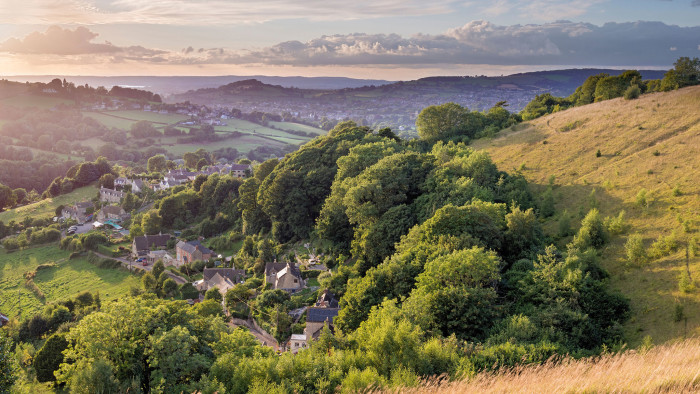The Stroud area: an earthy paradise

Simply sign up to the Life & Arts myFT Digest -- delivered directly to your inbox.
If reference to the Cotswolds conjures up images of smart second homes in manicured grounds and journeys in a 4x4 to the Daylesford organic farm shop, you are thinking of the east of the region. For many, the more authentic Cotswolds is further west, beyond daily commuting distance to London, in the county of Gloucestershire. And those who shun the fashionable east in favour of the less accessible west are well rewarded for their efforts.
The landscape is spectacular, especially the hillsides around the market town of Stroud. Everyday life is dominated by permanent residents more than commuters or holiday homeowners. And local estates are loosely fenced, with few crunchy gravel driveways or electronic gates, while the local farm shops sell . . . well, farm produce, rather than expensive spa accessories.
This is the part of the Cotswolds that has stayed “real” and, as a result, the housing market appears to offer excellent value compared to the east.
A typical home in Cirencester, a market town 95 miles northwest of London, is a modest £364,726. Ten miles further west and an average home in Stroud, also a market town, is £300,588. Yet in prettier eastern Cotswolds settlements such as Woodstock and Burford – both daily commuter favourites between 55 and 65 miles north of London – the average home sold so far this year has cost £419,641 and £500,261 respectively, according to website Zoopla.
There are practical reasons for the west’s more modest prices, of course. Commuters in the east can reach the capital in under an hour by train from Oxford or Banbury. By contrast, trains from Stroud to London take over 90 minutes, while the drive takes two hours or more. Added to that, while most of Gloucestershire is at least 30 minutes from the M4 or M5 motorways, eastern Cotswolds residents are often just a few minutes from the M40.

With the exception of Cheltenham, Gloucestershire’s urban areas are less glamorous than those in the east Cotswolds. Cirencester and Gloucester are smart but not showy, while Stroud – despite its new-age reputation – still has more fruit and vegetable markets, low-rent shops and greasy spoon cafés than reiki massage rooms.
“Your pound will go further and prices are not driven upwards in the way they have been in the east,” says William Leschallas of Jackson-Stops & Staff estate agency. The London influence on the country house market here is less from second home buyers than people leaving the rat race for good.
“These families are seeking a total lifestyle change and have sold in London or the Home Counties. They can upsize quite substantially for the same value as their previous property, or perhaps less,” says Liz Whittaker of Hamptons International’s Stroud office.

“Almost half our clients are from London, typically families with children looking for a home with a couple of acres between £1.5m and £3m,” says Sam Trounson of Strutt & Parker.
An important factor in determining where people buy is, therefore, ease of access to the area’s high-quality education, particularly the respected Beaudesert Park, Wycliffe, Stroud High and Marling Grammar schools. The most sought-after villages are those within reach of these and other respected schools and include Minchinhampton, Amberley, Nailsworth, Painswick, Sheepscombe and Frampton, along with the town of Tetbury.
Many incomers choose these locations because at least one adult in the household is commuting to Cheltenham, Cirencester or, at a push, Bristol, rather than London. Therefore salaries are lower and so are house prices.
In Painswick, Strutt & Parker is marketing an 18th-century manor house, substantially extended in the 19th century, which has 10 bedrooms and five bathrooms, a gym and wet room and 4.5 acres of grounds including outbuildings, a pool and a tennis court for £2.25m.
At Amberley, in an area of outstanding natural beauty, a six bedroom 19th-century house with period features and a walled garden is on sale for £1.15m through Hamptons International. Close by, a five-bedroom, six-bathroom detached house with just under an acre of mostly-landscaped grounds is for sale for £1.46m through Fine and Country.

Values of substantial country properties such as these – estimated by local agents to be between 60 and 70 per cent of the prices of comparable homes in the east Cotswolds – have risen. “Good quality houses are back to pre-downturn levels,” says Leschallas. “For the right property, prices exceed those seen seven years ago.”
There has long been a smattering of celebrity interest in Gloucestershire: singer Lily Allen and author Jilly Cooper have homes in the county, while actress Liz Hurley – amid a predictable blaze of media attention – has put her six-bedroom house near Cirencester on the market for £6m through Knight Frank. The country house of the Princess Royal, Gatcombe Park, is located close to Stroud.
Now the county’s reputation for good value is attracting overseas interest, too: one high-profile buying agency says it has this year seen its first requests from Russian and Chinese clients to be shown Gloucestershire farms and estates.
Will this trend eventually smooth Gloucestershire’s rougher edges, bringing a little of the eastern Cotswolds’ razzamatazz to the west? Probably not: the county will still be too far from London and too down-to-earth for many tastes. And that, of course, is exactly what makes the area so delightful for everyone else.
——————————————-
Buying guide
● Around 600,000 people live in Gloucestershire (2011 Census)
● More than half the county is in a designated area of outstanding natural beauty
● In May 2014 there were 4,512 reported crimes
What you can buy for . . .
£500,000 A five-bedroom stone house on the edge of Stroud
£1m A five-bedroom listed house in the centre of Cirencester
£2m A large rural manor house with five to 20 acres of land
Photograph of a view of Stroud: Wolstenholme Images/Alamy
Comments